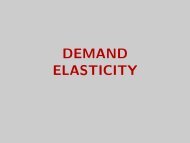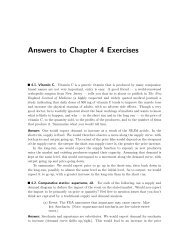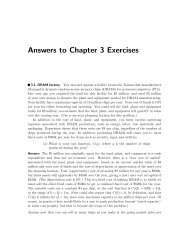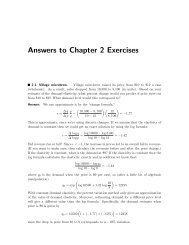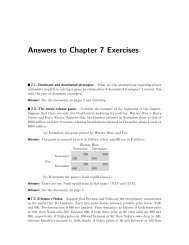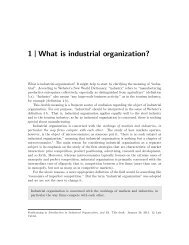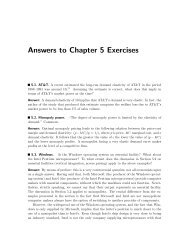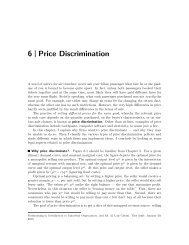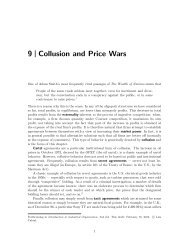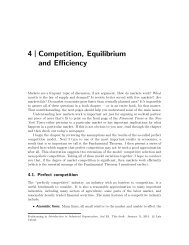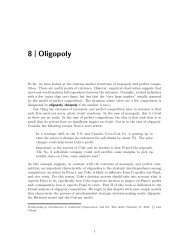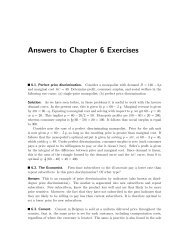5 Monopoly and Regulation - Luiscabral.net
5 Monopoly and Regulation - Luiscabral.net
5 Monopoly and Regulation - Luiscabral.net
You also want an ePaper? Increase the reach of your titles
YUMPU automatically turns print PDFs into web optimized ePapers that Google loves.
However, it is far from clear that the ECPR will bring any clear benefit. Supposethat mobile phone operators are equally efficient, that is, c 1 = c 2 . It can be seen thatT &M 1 ’s optimal price is p 1 = p M , the monopoly price. Consistently with the ECPR, theaccess price would then be set at w 2 = p M − c 1 . At this wholesale price, the best thedownstream firm can do is to sell at p M for a margin of zero. Whichever amount M 2 sells,the manufacturer receives full monopoly profits; <strong>and</strong> consumers pay monopoly prices. Inother words, although the ECPR implies productive efficiency, it has no bite with respectto price levels. In fact, prices are set at the same level as an unrestricted monopoly. j,8Despite these limitations, the ECPR is popular among regulators. In March of 1999,Deutsche Telekom was barred from launching a low-cost online service unless it were alsoto lower its access fee. Says the president of the regulatory authority: “To prevent discrimination(in pricing), the unbundled-access charge would have to be lowered.” 9 Otherwise,online service competitors such as AOL Europe would be at a disadvantage as they don’thave any way of accessing customers other than through Deutsche Telekom’s local loop.Broadly speaking, this decision reflects the spirit of the ECPR.The most clear example of application of the ECPR rule is however given by NewZeal<strong>and</strong>. The Telecom Corporation of New Zeal<strong>and</strong> (TCNZ) is the main telecommunicationsoperator. In particular, it holds the monopoly over the local <strong>net</strong>work. In the early 1990s,rival operator Clear Communications challenged TCNZ in Court, arguing that the latter’saccess charges were predatory, that is, were unfairly forcing Clear Communications out ofthe industry (cf Chapter 13). Clear Communications argued that Telecom ought to chargean access price in line with the actual cost of providing access. Telecom in turn wished toapply the ECPR rule, which, as seen above, may imply an access fee substantially higherthan the cost of providing access. Ultimately, the case was decided in London, where theLords of the Judicial Committee of the Privy Council upheld Telecom’s view. 10Summary• The monopoly model provides a good approximation to the behavior of dominant firms.• The degree of monopoly power is inversely related to the dem<strong>and</strong> elasticity faced by theseller. • The main areas of competition policy are price fixing, merger policy <strong>and</strong> abuseof dominant position. • A high-power regulation mechanism provides strong incentives forcost reduction but little incentives for quality provision. In addition, it implies a high degreeof risk for the regulated firm <strong>and</strong> requires strong commitment on the part of the regulator.Key concepts• patent • copyright • <strong>net</strong>work effects • Harberger triangle • allocativeinefficiency • excess burden • productive efficiency • rent seeking • residualj. To avoid this problem, some authors have proposed a solution whereby the upstream firm is subjectto a price-index cap. The price index includes both the final price set by the integrated firm <strong>and</strong> theaccess price charged to downstream competitors. This implies that, if the integrated firm wants toincrease the final price, it has to decrease the access price, <strong>and</strong> vice-versa.13



